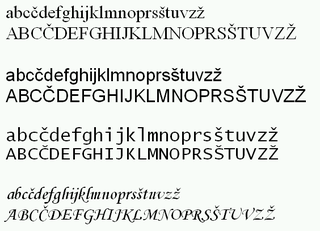Related Research Articles
Some Buddhist terms and concepts lack direct translations into English that cover the breadth of the original term. Below are given a number of important Buddhist terms, short definitions, and the languages in which they appear. In this list, an attempt has been made to organize terms by their original form and give translations and synonyms in other languages along with the definition.

The Slovene alphabet is an extension of the Latin script used to write Slovene. The standard language uses a Latin alphabet which is a slight modification of the Croatian Gaj's Latin alphabet, consisting of 25 lower- and upper-case letters:
When used as a diacritic mark, the term dot is usually reserved for the interpunct, or to the glyphs "combining dot above" ( ◌̇ ) and "combining dot below" ( ◌̣ ) which may be combined with some letters of the extended Latin alphabets in use in Central European languages and Vietnamese.
In cryptography, a classical cipher is a type of cipher that was used historically but for the most part, has fallen into disuse. In contrast to modern cryptographic algorithms, most classical ciphers can be practically computed and solved by hand. However, they are also usually very simple to break with modern technology. The term includes the simple systems used since Greek and Roman times, the elaborate Renaissance ciphers, World War II cryptography such as the Enigma machine and beyond.

Ndyuka, also called Aukan, Okanisi, Ndyuka tongo, Aukaans, Businenge Tongo, Eastern Maroon Creole, or Nenge is a creole language of Suriname and French Guiana, spoken by the Ndyuka people. The speakers are one of six Maroon peoples in the Republic of Suriname and one of the Maroon peoples in French Guiana. Most of the 25 to 30 thousand speakers live in the interior of the country, which is a part of the country covered with tropical rainforests. Ethnologue lists two related languages under the name Ndyuka, the other being a dialect of Lutos.
The Bassa language is a Kru language spoken by about 600,000 Bassa people in Liberia, Ivory Coast, and Sierra Leone.
Isoko is an Edoid language, one of the languages in Delta State spoken by the Isoko people in Isoko South, North and part of Ndokwa East Local Government Areas of Delta State, Southern part of Nigeria in Niger Delta region. It is also spoken in some part of Bayelsa. The Isoko language has close similarities between them and Edo people with other Edoid language because it is an Edoid language,the Isoko people are “an ethnic nationality made up of people and their ancestral roots can be traced through history to the Benin (Aka) kingdom, attested to by the linguistic and cultural similarities that exist between the Isoko people and the Benin (Aka)people” although a few of the Isoko communities or clans have their origins attached to the Ibo language and Urhobo language. Some 750,000 people consider themselves Isoko. Language is a mark of identity and plays an all-important role in the life of a people. The Isoko language however, is being threatened with extinction as reported by Idudhe (2002), as a result of neglect in teaching, learning and use. The Isoko language has about 20 to 21 dialects, but the Aviara/Uzere dialect is the standard dialect of the language.
The Kuku language, also called Kutuk na Kuku belongs to the Karo language group, of the Southeastern Nilotic branch of the Nilotic language family of the Southern Sudan and Northern Uganda. There is no standardized writing system for Kuku; it is sometimes written using the alphabet of a related language such as Bari or Kakwa, with the addition of characters to represent sounds that are not present in the other language. For example, the Bari alphabet can be adjusted for use in Kuku by adding the digraphs gb and kp to represent the voiced and voiceless labiovelar stops, respectively.
Konkomba is a Gurma language spoken in Ghana, Togo and Burkina Faso.
Afenmai (Afemai), or Yekhee, is an Edoid language spoken in Edo State, Nigeria by Afenmai people. Not all speakers recognize the name "Yekhee"; some use the district name Etsako.
Berom or Birom is the most widely spoken Plateau language in Nigeria. The language is locally numerically important and is consistently spoken by Berom of all ages in rural areas. However, the Berom are shifting to Hausa in cities. The small Cen and Nincut dialects may be separate languages. Approximately 1 million (2010) people speak in this language.
Hyam is a regionally important linguistic cluster of Plateau languages in Nigeria. Hyam of Nok is the prestige dialect. Writing the sociolinguistics of Hyam, Blench treats Sait, and Dzar as distinct varieties, and notes that Yat and Ankung may be viewed as separate languages, however, Hayab (2016) presents a differing opinion arguing that it is Ankung, a language called Iduya, that is not mutually intelligible to Hyam. Meanwhile, Hyam, which is spoken by the Ham people of Nigeria, popularly known as 'Jaba' in a recent study by Philip Hayab, a native of the area and a linguist who carried out in-depth research into the language, reveals that 'Jaba' has a Hausa etymology and is derogatory and should be discarded.
References
- ↑ Neyo at Ethnologue (18th ed., 2015) (subscription required)
- ↑ "Neyo language and alphabet". Omniglot. Retrieved 26 May 2021.